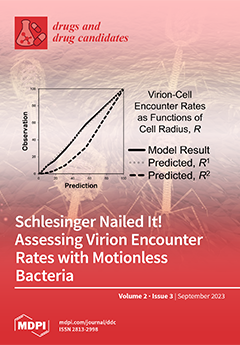Alzheimer’s disease (AD), an ongoing neurodegenerative disorder among the elderly, is signalized by amnesia, progressive deficiency in cognitive roles, and behavioral deformity. Over the last ten years, its pathogenesis still remains unclear despite several efforts from various researchers across the globe. There are
[...] Read more.
Alzheimer’s disease (AD), an ongoing neurodegenerative disorder among the elderly, is signalized by amnesia, progressive deficiency in cognitive roles, and behavioral deformity. Over the last ten years, its pathogenesis still remains unclear despite several efforts from various researchers across the globe. There are certain factors that seem to be involved in the progression of the disease such as the accumulation of β-amyloid, oxidative stress, the hyperphosphorylation of tau protein, and a deficit of acetylcholine (ACh). Ongoing therapeutics are mainly based on the cholinergic hypothesis, which suggests that the decrease in the ACh levels leads to the loss of memory. Therefore, increasing the cholinergic function seems to be beneficial. Acetylcholinesterase inhibitors (AChEIs) inhibit the enzyme by avoiding the cleavage of acetylcholine (ACh) and increasing the neurotransmitter acetylcholine (ACh) levels in the brain areas. Thus, the cholinergic deficit is the root cause of Alzheimer’s disease (AD). Currently, drugs such as tacrine, donepezil, rivastigmine, and galantamine have been launched on the market for a cholinergic approach to AD to increase neurotransmission at cholinergic synapses in the brain and to improve cognition. These commercialized medicines only provide supportive care, and there is a loss of medicinal strength over time. Therefore, there is a demand for investigating a novel molecule that overcomes the drawbacks of commercially available drugs. Therefore, butyrylcholinesterase (BChE), amyloid-
β (A
β),
β-secretase-1 (BACE), metals Cu(II), Zn(II), or Fe(II), antioxidant properties, and the free radical scavenging capacity have been primarily targeted in the preceding five years along with targeting the AChE enzyme. A desired, well-established pharmacological profile with a number of hybrid molecules incorporating substructures within a single scaffold has been investigated. From distinct chemical categories such as acridine, quinoline, carbamate, huperzine, and other heterocyclic analogs, the main substructures used in developing these molecules are derived. The optimization of activity through structural modifications of the prototype molecules has been followed to develop the Structure Activity Relationship (SAR), which in turn facilitates the development of novel molecules with expected AChE inhibitory activity together with many more pharmacological properties. The present review outlines the current drug candidates in the advancement of these AChEIs in the last two years.
Full article



